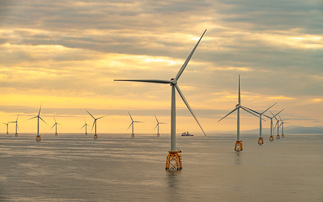In an event hosted by BusinessGreen, the energy and industry giants behind the largest industrial decarbonisation project in the UK sketched out their vision for how emissions produced by high carbon plants on England’s East Coast could be captured and stored under the North Sea
Could the UK establish one of the world's first zero carbon clusters, providing a template for the rest of the world's industrial heartlands to follow? That is certainly the hope of a growing band of companies across the UK that are convinced that a combination of renewable, carbon capture, and hydrogen technologies could allow even the most carbon intensive industries to decarbonise over the next few decades, creating thousands of jobs and helping to revive regional economies in the process.
Plans for these clusters are advancing fast, and in a webinar hosted by BusinessGreen last week senior executives from BP, SSE, Equinor, National Grid, CF Industries and Drax provided an update on how work is accelerating to develop a network of carbon capture pipelines that could connect industrial sites across England's north east.
The East Coast Cluster is the largest industrial decarbonisation project in the UK, bringing together some of the world's biggest energy companies in support of a plan to capture 20 million tonnes of carbon dioxide produced by industries on Teesside and Humberside and divert it to storage sites under the North Sea. The two regions are together responsible for half of the emissions produced by industrial clusters in the UK, and as such the project has the potential to take a sizeable bite out of the UK's emissions footprint and propel the country closer to its climate goals.
Andy Lane, managing director of the Northern Endurance Partnership, which is steering the collaboration, told attendees that the project could deliver industrial decarbonisation and economic benefits on an unprecedented scale.
"East Coast Cluster offers an unmatched scale - roughly 50 per cent of the cluster emissions produced around the whole of UK - and a huge diversity of different technologies and industries," he said. "It will create 25,000 jobs and bring together the two big decarbonisation initiatives in Humberside and Teesside."
Lane added that the Northern Endurance aquifer where the captured emissions would be stored is one of the largest and best understood storage sites in the UK, with tests revealing it could store 20 million tonnes of carbon by 2030. "That is equivalent to decarbonising six million homes in one go - it could have really significant impact on the carbon store here in the UK," he said.
Lane's comments were echoed by Equinor's low carbon strategy director Dan Sadler, who underscored the scheme had the potential to deliver a major impact on the UK's legally-binding climate change obligations while growing public awareness and confidence in critical clean technologies. "This infrastructure allows us to make tangible impacts on the UK's climate change obligations, decarbonising critical industrial clusters and protect their products while protecting and creating new jobs," he said. "It also allows us to grow public familiarity and acceptability for these new-to-the-UK systems. Beyond that, we can start to expand that infrastructure across the UK, alongside policy, to decarbonise the wider energy sector including heat, power and transport."
BusinessGreen's event was held as the Department for Business, Energy, and Industrial Strategy deliberates on which of the UK's industrial clusters it plans to place in the vanguard of the country's industrial decarbonisation drive. Out of a number of industrial cluster plans submitted late last week, BEIS will pick the two priority cluster projects that it assesses are more suited to deployment in the mid-2020s and sequence them on 'Track One' of its industrial decarbonisation plans. The companies behind the East Coast Cluster have high hopes the significant economic and climate impacts outlined in their bid will help edge out the competition and secure the project one of the coveted 'Track One' slots.
Analysis produced by the companies calculates that 2,200 direct jobs and 13,300 indirect jobs would be generated by the project once operational alongside 9,400 direct jobs and 12,300 indirect jobs in the construction phase. "It would carry enormous economic benefits while also positioning the UK at the forefront of the green products market and playing strongly into the levelling up areas of critical industrial regions," said Equinor's Sadler, as he outlined the workforce projections.
He added the East Coast Cluster could ultimately generate average annual gross value added (GVA) of around £2bn a year to the UK economy. "It's a huge jobs opportunity, with great economic benefits for the UK," he said.
Andrew Benjamin, head of project development at National Grid, emphasised that the sheer diversity of industries that would benefit from the installation of carbon capture and storage pipelines across the region also sets its bid apart from other clusters competing to become a 'Track One' project. "Diversity is very much at the heart of the East Coast Cluster," he said. "Combining Teesside and Humber industrial areas and the strength and skills and the representation there and bringing that together in an integrated way with transport and storage infrastructure to help capture carbon emissions is exceptional. There's a huge amount of collaboration going on, that diversity is our differentiating strength."
Once the priority cluster projects have been picked, all the high emitting industrial plants that hope to connect to the proposed CO2 transportation and storage infrastructure would likely have to enter a competition for government support so as to install the necessary carbon capture technologies and connect to the network.
The East Coast Cluster has identified 17 different primary capture projects that would be eligible for support, ranging from Drax's bioenergy and carbon capture and storage (BECCS) plant in Selby and SSE's plans to integrate CCUS into its power plants in Peterhead, to several projects to scale blue hydrogen, including BP's plan to build the UK's biggest blue hydrogen production facility on Teesside, and new biofuel and biochemical projects.
Matt Williamson, vice president for blue hydrogen at BP, showcased the four hydrogen projects that could be developed as part of the East Coast Cluster, arguing the region had "all the attributes to be a world class hydrogen hub", citing the region's natural resources, local skills base and high demand for fuel from local industry.
With capital spend developing all of the projects outlined in the pitch projected to exceed £12bn, delivering on East Coast Cluster vision will inevitably rely on private companies taking a punt on a range of emerging technologies. As such, the firms behind the project emphasised its delivery would depend on both on-going public support for so-called "primary capture projects" and the transportation and storage infrastructure that will link them up, and the creation of longer term business models that can create a competitive and appetising investment market for first movers.
"These are big, complicated projects that we are trying to establish here and a number of them are already running on critical path," Lane said. "Moving at pace to establish confidence in the regulatory environment is really important to meet the government's timing aspirations in getting CCUS clusters online by the end of the decade. We're up against it."
The government is currently working to finalise the policy environment that should enable such business models in each CCUS segment - transport and storage of CO2, CCUS-enabled hydrogen production, BECCS technology, and low carbon gas power enabled by CCUS - and it is hoped that a new policy framework can be finalised over the coming year. Lane emphasised that these policy frameworks would likely be critical for moving projects into construction and operation phase. "These are the rules of the road that allow you to understand risk and reward as an investor, and the support government is going to provide you," he explained.
Oonagh O'Grady, head of hydrogen development at SSE, stressed that the different prongs of the government's CCUS strategy needed to be developed cohesively, given the interlinked nature of industrial decarbonisation projects. "Some business models are more progressed than others," she said. "For example, the power CCUS business model is fairly well progressed, but there is no power CCUS unless you have the T&S (transport and storage) business model, because the two of them work together to form business case for a power CCUS. You can't have one without the other."
O'Grady also called on the government to use the COP26 Climate Summit to reiterate its commitment to advancing projects that can curb the country's industrial emissions. "COP26 is a fantastic opportunity for the UK to show it has committed to date, it's now about action," she said. "Post COP, it's really about the action aspect, and that reinforcement of commitment from government along with the business models will allow these projects to proceed."
However, she also acknowledged that there was an onus on industry players to drum up public acceptance of and support for CCUS technology. "These aren't technical projects, these are economic and social projects," she said. "You need buy-in from everyone to make then happen".
Indeed, CCUS technology has historically had a somewhat fraught relationship with the public, with participants in Climate Assembly UK last year concluding that only natural carbon capture methods should be used to meet the country's net zero targets and opposition to the carbon capture projects in Germany credited for the country's slow embrace of the technology. Similarly, a number of environmental campaign groups have been fiercely critical of the nascent CCUS industry, arguing that it would provide a lifeline to the fossil fuel industry and distract from the need to investment in renewables.
However, CCUS has been highlighted as critical to the UK reaching its net zero transition by the government's climate advisors the Climate Change Committee (CCC) and experts have repeatedly warned that without the adoption of new technologies that can curb industrial emissions global climate goals are likely to be missed.
Responding to concerns that CCUS technology could detract from other climate solutions that are less expensive and are not premised on the continued use of fossil fuels, Lane argued that carbon capture projects would not be delivered at the expense of other critical climate solutions. "There is an understandable desire in society for a silver bullet answer that solves all problems in decarbonisation," he said. "There isn't one… Each of these technologies has an important part to play. It is not about carbon capture as an alternative to renewable power, or carbon capture as an alternative to electric vehicles or housing insulation. It is about all of it and more."
The East Coast Cluster includes four different blue hydrogen projects and is therefore a major stakeholder in discussions about how the UK should scale the low carbon fuel. The government has long maintained it aims to deliver a "twin track approach" to scaling hydrogen that includes both blue hydrogen made using natural gas with CCUS and green hydrogen produced using renewables and water. It is expected to unveil more details about its approach in a Hydrogen Strategy, originally expected be published before Parliament's summer's recess but now looking likely to be delayed.
Environmentalists have raised the alarm in recent months that too much emphasis on blue hydrogen could keep the UK economy hooked on fossil fuels at precisely the moment it should be weaning itself off the oil and gas, but Equinor's Tanguy Cosmao countered that blue hydrogen projects could lead to the development of critical infrastructure that would ultimately enable the mass uptake of the low-carbon fuel as 'green hydrogen' supplies were also ramped up. "I don't think the two colours are in competition here," he told delegates. "Blue hydrogen is ready to go, its building on existing gas infrastructure. More importantly It will leverage and allow key hydrogen infrastructure that will be able to be used by green hydrogen, because the colour doesn't matter at the end of the day."
Meanwhile, Phil Conner from oil and gas pipeline firm Kellas Midstream emphasised that blue hydrogen was a necessary "transition technology" because it was ready to deploy at scale, unlike green hydrogen technology which is "developing fast but not at the same industrial scale as blue hydrogen can be deployed".
There is a long road ahead for the firms behind the East Coast Cluster as they wait to hear whether the plans have been selected by BEIS as a 'Track One' project, before then starting to navigate the various technical, societal, and policy challenges that surround the deployment of BECCS, CCUS, and hydrogen technologies. But it is equally clear that if the project can deliver on its immense promise, it could have a catalysing effect on the UK's progress towards its 2050 net zero mission while establishing the nation as a genuine leader in many of the industrial decarbonisation technologies that are set to play a key role in determining whether global climate goals are met.
BusinessGreen's webinar was hosted in association with the East Coast Cluster
Want to find out more about how the net zero transition could impact your business? Sign up now for a free pass to the Net Zero Festival this September.










